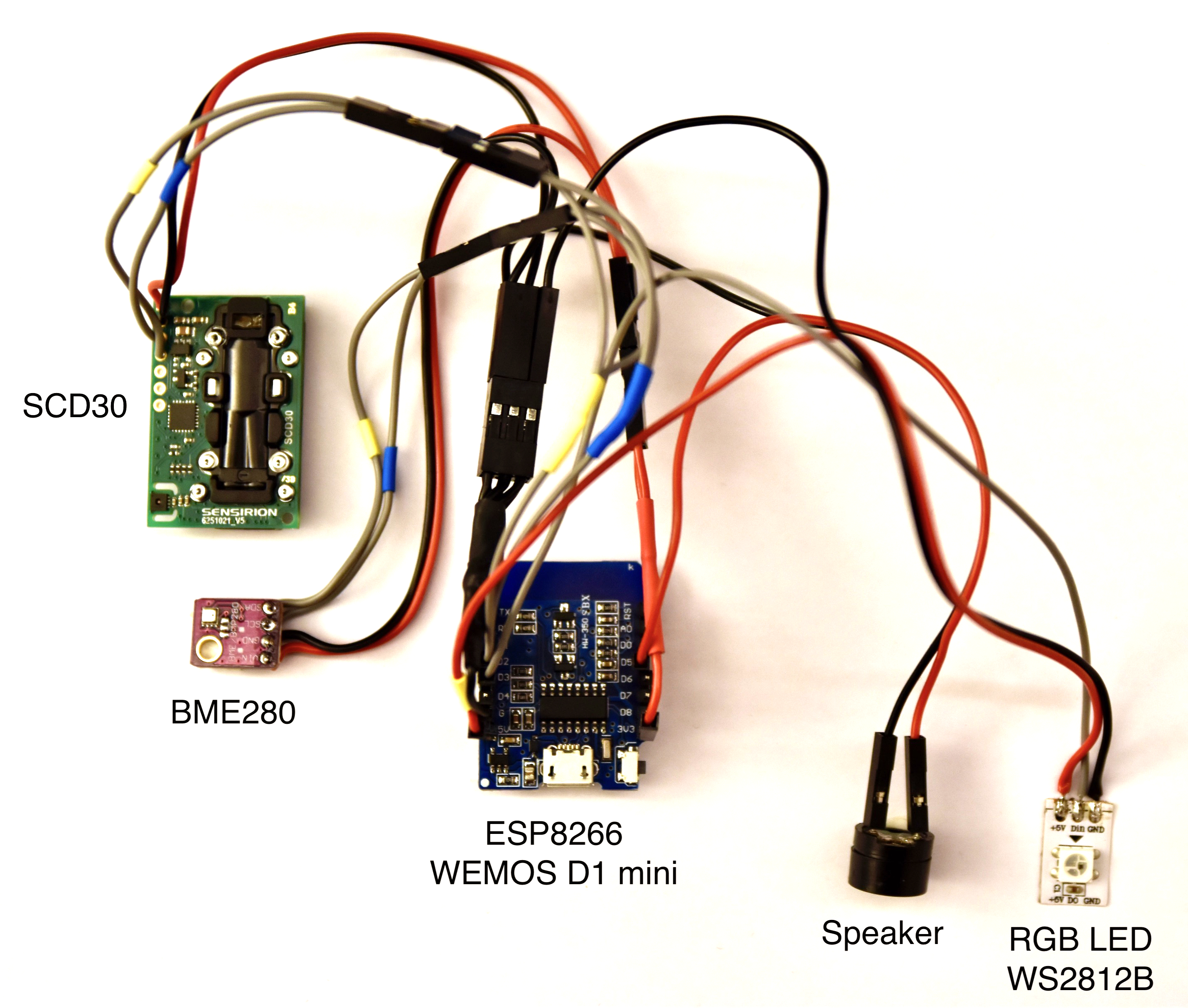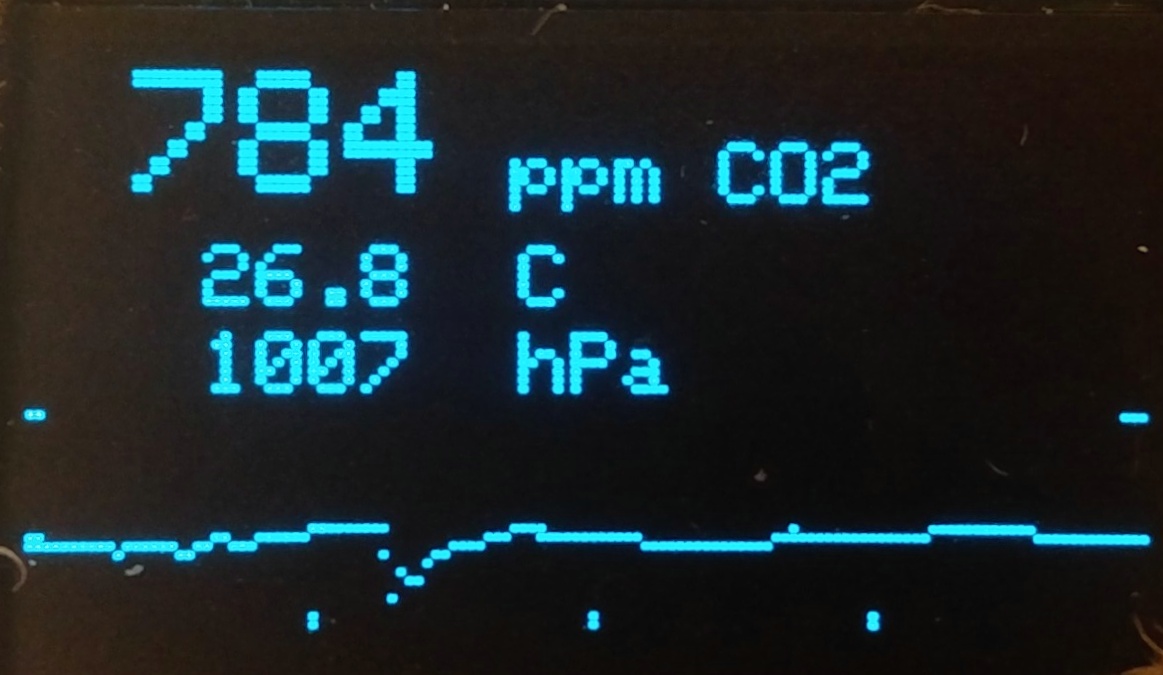Build a simple device that warns if CO₂ concentration in a room becomes a risk for COVID-19 aerosol infections.
Forked from CorO₂Sens by Kaspar Metz.
- Measures CO₂ concentration in room air.
- Controls an RGB LED (green, yellow, red, like a traffic light).
- A buzzer can be connected that alarms if levels are critical.
- Also opens a WiFi portal which shows current readings and a graph (not connected to the internet).
- Displays current CO₂, temperature and pressure values on a small display (optional)
- Can be built for ~ $60 / 50€ (parts cost).
This project was heavily inspired by ideas from Umwelt-Campus Birkenfeld.
You can also find a good overview of the topic by Rainer Winkler here: Recommendations for use of CO2 sensors to control room air quality during the COVID-19 pandemic.
- The sensor used here is the Sensirion SCD30 (around $50 / 40€) which is optionally augmented by a BME280 pressure sensor to improve accuracy.
- Look here if you want to use MH-Z19B sensors.
| LED color | CO₂ concentration |
|---|---|
| Green ("all good") | < 800 ppm |
| Yellow ("open windows") | 800 – 1000 ppm |
| Red ("leave room") | > 1000 ppm |
Based on a Recommendation from the REHVA (Federation of European Heating, Ventilation and Air Conditioning associations, rehva.eu) for preventing COVID-19 aerosol spread, especially in schools.
You can read current levels and a simple graph for the last hour by connecting to the WiFi coro2sens that is created.
Most devices will open a captive portal, immediately showing the data. You can also open http://10.0.0.1/ in a browser.
- Any ESP32 or ESP8266 board (like a WEMOS D32 (about $18 / 15€) or WEMOS LOLIN D1 Mini (about $7 / 6€)).
ESP32 has bluetooth, for future expansion. - Sensirion SCD30 I2C carbon dioxide sensor module (mouser, digikey) (around $50 / 40€).
- 1 NeoPixel compatible RGB LED (WS2812B, like the V2 Flora RGB Smart NeoPixel LED, you can also remove one from a larger strip which might be cheaper).
- A 3V piezo buzzer or a small speaker.
- Optional: Bosch BME280 I2C sensor module (like the GY-BME280 board), for air pressure compensation, improves accuracy (less than $5 / 4€).
- Optional: SSD1306 128x64 pixel OLED (Tested only on ESP32)
- A nice case :) Make shure the sensor has enough air flow.
| ESP8266 pin | ESP32 pin | goes to |
|---|---|---|
| 3V3 | 3V3 | SCD30 VIN, BME280 VIN, SSD1306 VIN |
| 5V | 5V | LED +5V |
| GND | GND | SCD30 GND, BME280 GND, LED GND, SSD1306 GND, Buzzer (-) |
| SCL / D1 | SCL / GPIO 22 | SCD30 SCL, BME280 SCL, SSD1306 SCL |
| SDA / D2 | SDA / GPIO 21 | SCD30 SDA, BME280 SDA, SSD1306 SDA |
| GPIO 0 / D3 | GPIO 16 | LED DIN |
| GPIO 14 / D5 | GPIO 19 | Buzzer (+) |
Flashing the ESP using PlatfomIO
- Simply open the project, select your env (
esp12efor ESP8266 /esp32devfor ESP32) and run / upload. - Or via command line:
pio run -t -e esp12e uploadfor ESP8266.pio run -t -e esp32dev uploadfor ESP32.
- Libraries will be installed automatically.
- Install the latest Arduino IDE.
- Download the latest code and unzip it somewhere.
- Open
coro2sense.inoin thecoro2senssub folder in your Arduino IDE. - Install (or update) your board platform:
(Tools –> Board –> Board Manager...)- Install
esp8266oresp32.
- Install
- Install (or update) the following libraries using the built-in library manager:
(Tools –> Library Manager...)- For ESP8266:
SparkFun BME280FastLEDadafruit/Adafruit SSD1306adafruit/Adafruit GFX Libraryadafruit/Adafruit BusIO
- For ESP32:
SparkFun SCD30 Arduino LibrarySparkFun BME280FastLEDadafruit/Adafruit SSD1306adafruit/Adafruit GFX Libraryadafruit/Adafruit BusIO
- For ESP8266:
- Install the following external libraries:
(download .zip file, then import it via Sketch –> Include Library –> Add .ZIP Library...)- For ESP8266:
- For ESP32:
- Run & upload :)
Please let me know of any issues you might encounter (open a GitHub issue or write me on twitter.com/kmetz or k@kjpm.de).

